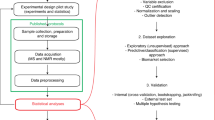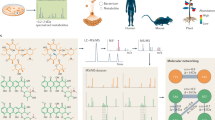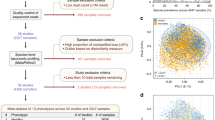Abstract
Metabonomics—the study of metabolic changes in an integrated biologic system—is an emerging field. This discipline joins the other 'omics' (genomics, transcriptomics and proteomics) to give rise to a comprehensive, systems-biology approach to the evaluation of holistic in vivo function. Metabonomics, especially when based on nuclear magnetic resonance spectroscopy, has the potential to identify biomarkers and prognostic factors, enhance clinical diagnosis, and expand hypothesis generation. As a consequence, the use of metabonomics has been extensively explored in the past decade, and applied successfully to the study of human diseases, toxicology, microbes, nutrition, and plant biology. This Review introduces the basic principles of nuclear magnetic resonance spectroscopy and commonly used tools for multivariate data analysis, before considering the applications and future potential of metabonomics in basic and clinical research, with emphasis on applications in the field of gastroenterology.
Key Points
-
Metabonomics has become increasingly attractive, as genomics and proteomics only tells us what might happen, but metabonomics tells us what actually did happen
-
NMR spectroscopy has several advantages, because it is rapid, requires minimal or no sample preparation, is non-destructive of the samples, requires only small sample amounts, and often allows use of samples acquired in a noninvasive or minimally invasive manner; it has an unequalled reproducibility and stability, and is virtually the only technique available that can investigate the metabolic composition of intact tissue
-
NMR spectroscopy based metabonomics has the potential of becoming an extremely powerful platform in terms of biomarker identification, improving clinical diagnostic and prognostic information, and hypothesis generation
-
Metabonomics joins the other 'omics'—genomics, transcriptomics and proteomics—as sciences that collectively gives rise to a comprehensive, systems-biology approach to the evaluation of holistic in vivo function
-
Integration of the different 'omics' is a relatively new concept, especially in the field of gastroenterology, and further investigation into their possible applications is warranted
This is a preview of subscription content, access via your institution
Access options
Subscribe to this journal
Receive 12 print issues and online access
$209.00 per year
only $17.42 per issue
Buy this article
- Purchase on Springer Link
- Instant access to full article PDF
Prices may be subject to local taxes which are calculated during checkout






Similar content being viewed by others
References
Nicholson JK et al. (1999) 'Metabonomics': understanding the metabolic responses of living systems to pathophysiological stimuli via multivariate statistical analysis of biological NMR spectroscopic data. Xenobiotica 29: 1181–1189
Mitchell S and Carmichael PL (2005) Metabonomics and the endocrine system. Mol Cell Endocrinol 244: 10–14
Raamsdonk LM et al. (2001) A functional genomics strategy that uses metabolome data to reveal the phenotype of silent mutations. Nat Biotechnol 19: 45–50
Schmidt C (2004) Metabolomics takes its place as latest up-and-coming “omic” science. J Natl Cancer Inst 96: 732–734
Bezabeh T et al. (2001) The use of 1H magnetic resonance spectroscopy in inflammatory bowel diseases: distinguishing ulcerative colitis from Crohn's disease. Am J Gastroenterol 96: 442–448
Marchesi JR et al. (2007) Rapid and noninvasive metabonomic characterization of inflammatory bowel disease. J Proteome Res 6: 546–551
Brindle JT et al. (2002) Rapid and noninvasive diagnosis of the presence and severity of coronary heart disease using 1H-NMR-based metabonomics. Nat Med 8: 1439–1444
Kirschenlohr HL et al. (2006) Proton NMR analysis of plasma is a weak predictor of coronary artery disease. Nat Med 12: 705–710
Griffin JL et al. (2002) Metabolic profiles of dystrophin and utrophin expression in mouse models of Duchenne muscular dystrophy. FEBS Lett 530: 109–116
Prabakaran S et al. (2004) Mitochondrial dysfunction in schizophrenia: evidence for compromised brain metabolism and oxidative stress. Mol Psychiatry 9: 684–697
Griffin JL and Bollard ME (2004) Metabonomics: its potential as a tool in toxicology for safety assessment and data integration. Curr Drug Metab 5: 389–398
Nicholson JK et al. (2002) Metabonomics: a platform for studying drug toxicity and gene function. Nat Rev Drug Discov 1: 153–161
Coen M et al. (2004) Integrated application of transcriptomics and metabonomics yields new insight into the toxicity due to paracetamol in the mouse. J Pharm Biomed Anal 35: 93–105
Craig A et al. (2006) Systems toxicology: integrated genomic, proteomic and metabonomic analysis of methapyrilene induced hepatotoxicity in the rat. J Proteome Res 5: 1586–1601
Griffin JL et al. (2004) An integrated reverse functional genomic and metabolic approach to understanding orotic acid-induced fatty liver. Physiol Genomics 17: 140–149
Schnackenberg LK et al. (2006) An integrated study of acute effects of valproic acid in the liver using metabonomics, proteomics, and transcriptomics platforms. OMICS 10: 1–14
Tang W (2007) Drug metabolite profiling and elucidation of drug-induced hepatotoxicity. Expert Opin Drug Metab Toxicol 3: 407–420
Rezzi S et al. (2007) Nutritional metabonomics: applications and perspectives. J Proteome Res 6: 513–525
Kemsley EK et al. (2007) Multivariate techniques and their application in nutrition: a metabolomics case study. Br J Nutr 98: 1–14
Fiehn O et al. (2000) Metabolite profiling for plant functional genomics. Nat Biotechnol 18: 1157–1161
Allen J et al. (2003) High-throughput classification of yeast mutants for functional genomics using metabolic footprinting. Nat Biotechnol 21: 692–696
Macomber RS (1998) A Complete Introduction to Modern NMR Spectroscopy. New York: John Wiley & Sons Inc.
Lindon JC et al. (2003) So what's the deal with metabonomics? Anal Chem 75: 384A–391A
Nicholson JK and Wilson ID (2003) Opinion: understanding 'global' systems biology: metabonomics and the continuum of metabolism. Nat Rev Drug Discov 2: 668–676
Reo NV (2002) NMR-based metabolomics. Drug Chem Toxicol 25: 375–382
Garrod S et al. (1999) High-resolution magic angle spinning 1H NMR spectroscopic studies on intact rat renal cortex and medulla. Magn Reson Med 41: 1108–1118
Moka D et al. (1998) Biochemical classification of kidney carcinoma biopsy samples using magic-angle-spinning 1H nuclear magnetic resonance spectroscopy. J Pharm Biomed Anal 17: 125–132
Cheng LL et al. (1997) Quantitative neuropathology by high resolution magic angle spinning proton magnetic resonance spectroscopy. Proc Natl Acad Sci USA 94: 6408–6413
Millis KK et al. (1997) Gradient, high-resolution, magic-angle spinning nuclear magnetic resonance spectroscopy of human adipocyte tissue. Magn Reson Med 38: 399–403
Tomlins AM et al. (1998) High resolution 1H NMR spectroscopic studies on dynamic biochemical processes in incubated human seminal fluid samples. Biochim Biophys Acta 1379: 367–380
Lenz EM and Wilson ID (2007) Analytical strategies in metabonomics. J Proteome Res 6: 443–458
Keun HC et al. (2002) Analytical reproducibility in 1H NMR-based metabonomic urinalysis. Chem Res Toxicol 15: 1380–1386
Chen JH et al. (2001) Biochemical analysis using high-resolution magic angle spinning NMR spectroscopy distinguishes lipoma-like well-differentiated liposarcoma from normal fat. J Am Chem Soc 123: 9200–9201
Griffin JL et al. (2003) Cellular environment of metabolites and a metabonomic study of tamoxifen in endometrial cells using gradient high resolution magic angle spinning 1H NMR spectroscopy. Biochim Biophys Acta 1619: 151–158
Wang Y et al. (2003) Spectral editing and pattern recognition methods applied to high-resolution magic-angle spinning 1H nuclear magnetic resonance spectroscopy of liver tissues. Anal Biochem 323: 26–32
Liu M et al. (1997) Measurement of biomolecular diffusion coefficients in blood plasma using two-dimensional 1H–1H diffusion-edited total-correlation NMR spectroscopy. Anal Chem 69: 1504–1509
Cheng LL et al. (1998) Evaluating human breast ductal carcinomas with high-resolution magic-angle spinning proton magnetic resonance spectroscopy. J Magn Reson 135: 194–202
Keun HC et al. (2002) Cryogenic probe 13C NMR spectroscopy of urine for metabonomic studies. Anal Chem 74: 4588–4593
Deming SN (1986) Chemometrics: an overview. Clin Chem 32: 1702–1706
Eriksson L et al. (2004) Using chemometrics for navigating in the large data sets of genomics, proteomics, and metabonomics (gpm). Anal Bioanal Chem 380: 419–429
Eriksson L et al. (2006) Megavariate analysis of environmental QSAR data. Part I—a basic framework founded on principal component analysis (PCA), partial least squares (PLS), and statistical molecular design (SMD). Mol Divers 10: 169–186
Eriksson L et al. (2006) Megavariate analysis of environmental QSAR data. Part II—investigating very complex problem formulations using hierarchical, non-linear and batch-wise extensions of PCA and PLS. Mol Divers 10: 187–205
Lindon JC et al. (2001) Pattern recognition methods and applications in biomedical magnetic resonance. Prog NMR Spect 39: 1–40
Trygg J et al. (2007) Chemometrics in metabonomics. J Proteome Res 6: 469–479
Lavine B and Workman JJ Jr (2004) Chemometrics. Anal Chem 76: 3365–3371
Wang Y et al. (2008) Magic angle spinning NMR and 1H–31P heteronuclear statistical total correlation spectroscopy of intact human gut biopsies. Anal Chem 80: 1058–1066
Schlens J (online 10 December 2005) A tutorial on principal component analysis. [http://www.snl.salk.edu/~shlens/pub/notes/pca.pdf] (accessed 4 March 2008)
Cloarec O et al. (2005) Statistical total correlation spectroscopy: an exploratory approach for latent biomarker identification from metabolic 1H NMR data sets. Anal Chem 77: 1282–1289
Trygg J and Wold S (2003) O2-PLS, a two-block (X–Y) latent variable regression (LVR) method with an integral OSC filter. J Chemomet 17: 53–64
Trygg J (2002) O2-PLS for qualitative and quantitative analysis in multivariate calibration. J Chemomet 16: 283–293
Holmes E et al. (2007) Detection of urinary drug metabolite (xenometabolome) signatures in molecular epidemiology studies via statistical total correlation (NMR) spectroscopy. Anal Chem 79: 2629–2640
Coen M et al. (2007) Heteronuclear 1H–31P statistical total correlation NMR spectroscopy of intact liver for metabolic biomarker assignment: application to galactosamine-induced hepatotoxicity. Anal Chem 79: 8956–8966
Geboes K and De HG (2003) Indeterminate colitis. Inflamm Bowel Dis 9: 324–331
Hildebrand H et al. (1991) Chronic inflammatory bowel disease in children and adolescents in Sweden. J Pediatr Gastroenterol Nutr 13: 293–297
Lennard-Jones JE and Shivananda S (1997) Clinical uniformity of inflammatory bowel disease at presentation and during the first year of disease in the north and south of Europe. Eur J Gastroenterol Hepatol 9: 353–359
Meucci G et al. (1999) Frequency and clinical evolution of indeterminate colitis: a retrospective multi-centre study in northern Italy. Eur J Gastroenterol Hepatol 11: 909–913
Nicholls RJ and Wells AD (1992) Indeterminate colitis. Baillieres Clin Gastroenterol 6: 105–112
Riegler G et al. (1997) Clinical evolution in an outpatient series with indeterminate colitis. Dis Colon Rectum 40: 437–439
Csillag C et al. (2007) Clinical phenotype and gene expression profile in Crohn's disease. Am J Physiol Gastrointest Liver Physiol 292: G298–G304
Distler P and Holt PR (1997) Are right- and left-sided colon neoplasms distinct tumors? Dig Dis 15: 302–311
Glebov OK et al. (2003) Distinguishing right from left colon by the pattern of gene expression. Cancer Epidemiol Biomarkers Prev 12: 755–762
Wang Y et al. (2005) Biochemical characterization of rat intestine development using high-resolution magic-angle-spinning 1H NMR spectroscopy and multivariate data analysis. J Proteome Res 4: 1324–1329
Bates MD et al. (2002) Novel genes and functional relationships in the adult mouse gastrointestinal tract identified by microarray analysis. Gastroenterology 122: 1467–1482
Wang Y et al. (2007) Topographical variation in metabolic signatures of human gastrointestinal biopsies revealed by high-resolution magic-angle spinning 1H NMR spectroscopy. J Proteome Res 6: 3944–3951
Saric J et al. (2008) Species variation in the fecal metabolome gives insight into differential gastrointestinal function. J Proteome Res 7: 352–360
Nielsen OH et al. (2000) Clinical reviews: established and emerging biological activity markers of inflammatory bowel disease. Am J Gastroenterol 95: 359–367
Wang Y et al. (2004) Metabonomic investigations in mice infected with Schistosoma mansoni: an approach for biomarker identification. Proc Natl Acad Sci USA 101: 12676–12681
Gerstle RJ et al. (2000) The role of neural networks in improving the accuracy of MR spectroscopy for the diagnosis of head and neck squamous cell carcinoma. AJNR Am J Neuroradiol 21: 1133–1138
Griffin JL and Shockcor JP (2004) Metabolic profiles of cancer cells. Nat Rev Cancer 4: 551–561
Hagberg G (1998) From magnetic resonance spectroscopy to classification of tumors: a review of pattern recognition methods. NMR Biomed 11: 148–156
Howells SL et al. (1992) An investigation of tumor 1H nuclear magnetic resonance spectra by the application of chemometric techniques. Magn Reson Med 28: 214–236
Preul MC et al. (1998) Using pattern analysis of in vivo proton MRSI data to improve the diagnosis and surgical management of patients with brain tumors. NMR Biomed 11: 192–200
Usenius JP et al. (1996) Automated classification of human brain tumours by neural network analysis using in vivo1H magnetic resonance spectroscopic metabolite phenotypes. Neuroreport 7: 1597–1600
Nelson SJ and Cha S (2003) Imaging glioblastoma multiforme. Cancer J 9: 134–145
Preul MC et al. (1996) Accurate, noninvasive diagnosis of human brain tumors by using proton magnetic resonance spectroscopy. Nat Med 2: 323–325
Guillevin R et al. (2007) Proton magnetic resonance spectroscopy predicts proliferative activity in diffuse low-grade gliomas. J Neurooncol [10.1007/s11060-007-9508-y]
Shukla-Dave A et al. (2002) Prediction of treatment response of head and neck cancers with 31P MR spectroscopy from pretreatment relative phosphomonoester levels. Acad Radiol 9: 688–694
Bolan PJ et al. (2003) In vivo quantification of choline compounds in the breast with 1H MR spectroscopy. Magn Reson Med 50: 1134–1143
Meisamy S et al. (2004) Neoadjuvant chemotherapy of locally advanced breast cancer: predicting response with in vivo1H MR spectroscopy—a pilot study at 4 T. Radiology 233: 424–431
Claudino WM et al. (2007) Metabolomics: available results, current research projects in breast cancer, and future applications. J Clin Oncol 25: 2840–2846
Bell JD and Bhakoo KK (1998) Metabolic changes underlying 31P MR spectral alterations in human hepatic tumours. NMR Biomed 11: 354–359
Li CW et al. (2005) Quantification of choline compounds in human hepatic tumors by proton MR spectroscopy at 3 T. Magn Reson Med 53: 770–776
Mueller-Lisse UG et al. (2001) Localized prostate cancer: effect of hormone deprivation therapy measured by using combined three-dimensional 1H MR spectroscopy and MR imaging: clinicopathologic case–controlled study. Radiology 221: 380–390
van Dorsten FA et al. (2004) Combined quantitative dynamic contrast-enhanced MR imaging and 1H MR spectroscopic imaging of human prostate cancer. J Magn Reson Imaging 20: 279–287
Arias-Mendoza F et al. (2004) Predicting treatment response in non-Hodgkin's lymphoma from the pretreatment tumor content of phosphoethanolamine plus phosphocholine. Acad Radiol 11: 368–376
Griffiths JR et al. (2002) Metabolic changes detected by in vivo magnetic resonance studies of HEPA-1 wild-type tumors and tumors deficient in hypoxia-inducible factor-1β (HIF-1β): evidence of an anabolic role for the HIF-1 pathway. Cancer Res 62: 688–695
Griffithsv JR and Stubbs M (2003) Opportunities for studying cancer by metabolomics: preliminary observations on tumors deficient in hypoxia-inducible factor 1. Adv Enzyme Regul 43: 67–76
Zhong H et al. (1999) Overexpression of hypoxia-inducible factor 1α in common human cancers and their metastases. Cancer Res 59: 5830–5835
Clish CB et al. (2004) Integrative biological analysis of the APOE*3-leiden transgenic mouse. OMICS 8: 3–13
Mayr M et al. (2004) Proteomic and metabolomic analysis of vascular smooth muscle cells: role of PKCδ. Circ Res 94: e87–e96
Verhoeckx KC et al. (2004) Characterization of anti-inflammatory compounds using transcriptomics, proteomics, and metabolomics in combination with multivariate data analysis. Int Immunopharmacol 4: 1499–1514
Wong MS et al. (2004) Metabolic and transcriptional patterns accompanying glutamine depletion and repletion in mouse hepatoma cells: a model for physiological regulatory networks. Physiol Genomics 16: 247–255
Griffin JL et al. (2007) The influence of pharmacogenetics on fatty liver disease in the Wistar and Kyoto rats: a combined transcriptomic and metabonomic study. J Proteome Res 6: 54–61
Heijne WH et al. (2003) Toxicogenomics of bromobenzene hepatotoxicity: a combined transcriptomics and proteomics approach. Biochem Pharmacol 65: 857–875
Heijne WH et al. (2005) Systems toxicology: applications of toxicogenomics, transcriptomics, proteomics and metabolomics in toxicology. Expert Rev Proteomics 2: 767–780
Heijne WH et al. (2005) Profiles of metabolites and gene expression in rats with chemically induced hepatic necrosis. Toxicol Pathol 33: 425–433
Kleno TG et al. (2004) Combination of 'omics' data to investigate the mechanism(s) of hydrazine-induced hepatotoxicity in rats and to identify potential biomarkers. Biomarkers 9: 116–138
Ruepp SU et al. (2002) Genomics and proteomics analysis of acetaminophen toxicity in mouse liver. Toxicol Sci 65: 135–150
Stegmann A et al. (2006) Metabolome, transcriptome, and bioinformatic cis-element analyses point to HNF-4 as a central regulator of gene expression during enterocyte differentiation. Physiol Genomics 27: 141–155
Dumas ME et al. (2007) Direct quantitative trait locus mapping of mammalian metabolic phenotypes in diabetic and normoglycemic rat models. Nat Genet 39: 666–672
Gupta RB et al. (2007) Histologic inflammation is a risk factor for progression to colorectal neoplasia in ulcerative colitis: a cohort study. Gastroenterology 133: 1099–1105
Acknowledgements
This paper was supported by grants from the Danish Research Council, the Augustinus Foundation, Aase and Ejnar Danielsen's Foundation, Director Emil C Hertz and spouse Inger Hertz Foundation, and the Foundation of Graduate Engineer Frode V Nyegaard and spouse.
Author information
Authors and Affiliations
Corresponding author
Ethics declarations
Competing interests
The authors declare no competing financial interests.
Rights and permissions
About this article
Cite this article
Bjerrum, J., Nielsen, O., Wang, Y. et al. Technology Insight: metabonomics in gastroenterology—basic principles and potential clinical applications. Nat Rev Gastroenterol Hepatol 5, 332–343 (2008). https://doi.org/10.1038/ncpgasthep1125
Received:
Accepted:
Published:
Issue Date:
DOI: https://doi.org/10.1038/ncpgasthep1125
This article is cited by
-
Metabolomic profiling of bovine leucocytes transformed by Theileria annulata under BW720c treatment
Parasites & Vectors (2022)
-
Repeated administration of the NSAID meloxicam alters the plasma and urine lipidome
Scientific Reports (2019)
-
Metabonomics of human fecal extracts characterize ulcerative colitis, Crohn’s disease and healthy individuals
Metabolomics (2015)
-
Integration of transcriptomics and metabonomics: improving diagnostics, biomarker identification and phenotyping in ulcerative colitis
Metabolomics (2014)
-
GC/MS-based profiling of amino acids and TCA cycle-related molecules in ulcerative colitis
Inflammation Research (2011)



